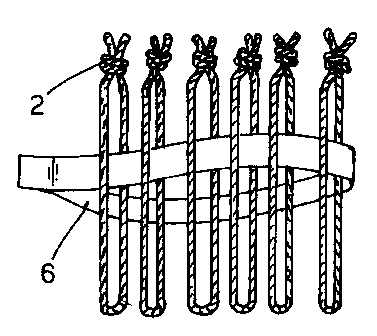Some of the information on this Web page has been provided by external sources. The Government of Canada is not responsible for the accuracy, reliability or currency of the information supplied by external sources. Users wishing to rely upon this information should consult directly with the source of the information. Content provided by external sources is not subject to official languages, privacy and accessibility requirements.
Any discrepancies in the text and image of the Claims and Abstract are due to differing posting times. Text of the Claims and Abstract are posted:
| (12) Patent: | (11) CA 2313491 |
|---|---|
| (54) English Title: | A METHOD FOR FORMING ELASTIC RINGS INTO BUNCHES FOR BINDING CHICKENS, ROASTS AND VARIOUS MEAT PRODUCTS |
| (54) French Title: | SYSTEME FONCTIONNEL POUR LA CREATION DE GROUPES ELASTIQUES EN PAQUETS SERVANT A ATTACHER DES POULETS, ROTIS, ET DIVERS PRODUITS DE VIANDE |
| Status: | Expired and beyond the Period of Reversal |
| (51) International Patent Classification (IPC): |
|
|---|---|
| (72) Inventors : |
|
| (73) Owners : |
|
| (71) Applicants : |
|
| (74) Agent: | MARKS & CLERK |
| (74) Associate agent: | |
| (45) Issued: | 2005-09-06 |
| (22) Filed Date: | 2000-07-10 |
| (41) Open to Public Inspection: | 2001-01-14 |
| Examination requested: | 2001-07-25 |
| Availability of licence: | N/A |
| Dedicated to the Public: | N/A |
| (25) Language of filing: | English |
| Patent Cooperation Treaty (PCT): | No |
|---|
| (30) Application Priority Data: | ||||||
|---|---|---|---|---|---|---|
|
Disclosed is a method for forming elastic rings into bunches for binding a meat product, wherein a bunch of elastic rings is formed by placing the elastic rings lightly tensioned between two rods, appropriately spaced, wherein the elastic rings are pushed one near to the other on the rods in order to form two walls, and wherein one of these walls is bound by a releasable strip, whereby, at time of use, the strip is removed to release elastic rings for binding the meat product.
Système fonctionnel pour la création de groupes élastiques en paquets servant à attacher des produits de viande, dans lequel un paquet de groupes élastiques se forme en plaçant des groupes élastiques légèrement tendus entre deux tringles, espacées de manière appropriée, les groupes élastiques sont alors poussés l'un vers l'autre sur les tringles pour former deux parois, et une de ces parois est liée par une bande amovible qui, lors de l'utilisation, est ôtée pour libérer les groupes élastiques permettant d'attacher le produit de viande.
Note: Claims are shown in the official language in which they were submitted.
Note: Descriptions are shown in the official language in which they were submitted.

2024-08-01:As part of the Next Generation Patents (NGP) transition, the Canadian Patents Database (CPD) now contains a more detailed Event History, which replicates the Event Log of our new back-office solution.
Please note that "Inactive:" events refers to events no longer in use in our new back-office solution.
For a clearer understanding of the status of the application/patent presented on this page, the site Disclaimer , as well as the definitions for Patent , Event History , Maintenance Fee and Payment History should be consulted.
| Description | Date |
|---|---|
| Time Limit for Reversal Expired | 2017-07-10 |
| Letter Sent | 2016-07-11 |
| Inactive: IPC from MCD | 2006-03-12 |
| Grant by Issuance | 2005-09-06 |
| Inactive: Cover page published | 2005-09-05 |
| Inactive: Final fee received | 2005-05-20 |
| Pre-grant | 2005-05-20 |
| Notice of Allowance is Issued | 2005-02-11 |
| Letter Sent | 2005-02-11 |
| Notice of Allowance is Issued | 2005-02-11 |
| Inactive: Approved for allowance (AFA) | 2005-01-31 |
| Amendment Received - Voluntary Amendment | 2004-12-20 |
| Inactive: S.29 Rules - Examiner requisition | 2004-06-28 |
| Inactive: S.30(2) Rules - Examiner requisition | 2004-06-28 |
| Inactive: IPC assigned | 2004-01-20 |
| Inactive: IPC assigned | 2004-01-20 |
| Inactive: First IPC assigned | 2004-01-20 |
| Inactive: Entity size changed | 2002-07-23 |
| Amendment Received - Voluntary Amendment | 2002-04-18 |
| Amendment Received - Voluntary Amendment | 2002-01-09 |
| Letter Sent | 2001-08-23 |
| Request for Examination Received | 2001-07-25 |
| Request for Examination Requirements Determined Compliant | 2001-07-25 |
| All Requirements for Examination Determined Compliant | 2001-07-25 |
| Application Published (Open to Public Inspection) | 2001-01-14 |
| Inactive: Cover page published | 2001-01-14 |
| Inactive: First IPC assigned | 2000-09-05 |
| Inactive: Filing certificate - No RFE (English) | 2000-08-14 |
| Filing Requirements Determined Compliant | 2000-08-14 |
| Letter Sent | 2000-08-14 |
| Application Received - Regular National | 2000-08-12 |
There is no abandonment history.
The last payment was received on 2005-06-21
Note : If the full payment has not been received on or before the date indicated, a further fee may be required which may be one of the following
Please refer to the CIPO Patent Fees web page to see all current fee amounts.
Note: Records showing the ownership history in alphabetical order.
| Current Owners on Record |
|---|
| FRA PRODUCTION SPA |
| Past Owners on Record |
|---|
| GIUSEPPE MIGNONE |